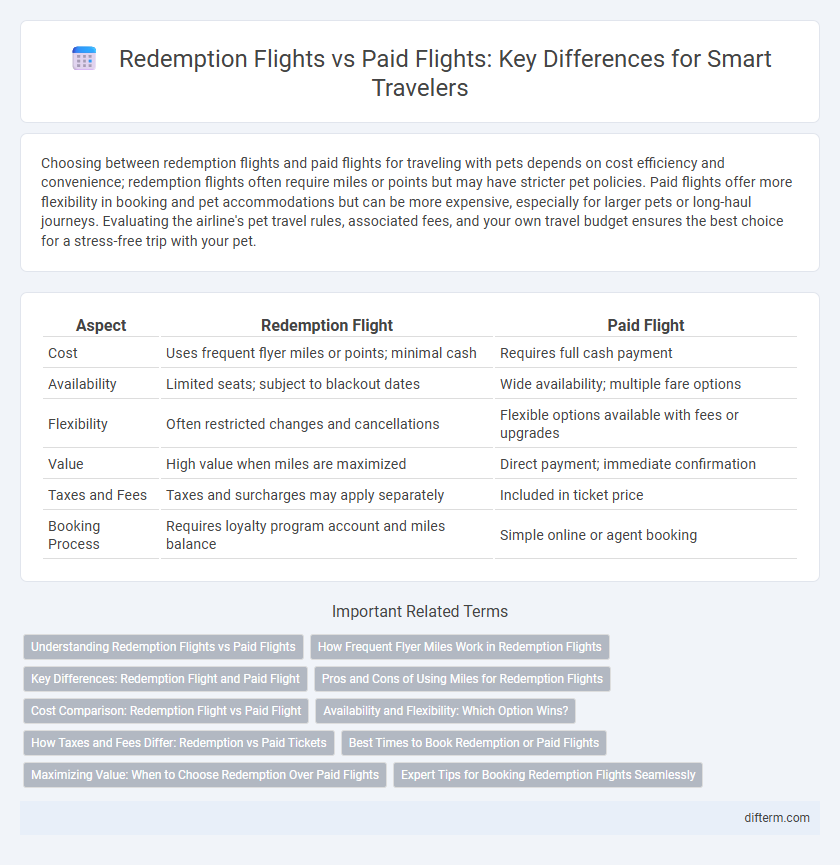Choosing between redemption flights and paid flights for traveling with pets depends on cost efficiency and convenience; redemption flights often require miles or points but may have stricter pet policies. Paid flights offer more flexibility in booking and pet accommodations but can be more expensive, especially for larger pets or long-haul journeys. Evaluating the airline's pet travel rules, associated fees, and your own travel budget ensures the best choice for a stress-free trip with your pet.
Table of Comparison
| Aspect | Redemption Flight | Paid Flight |
|---|---|---|
| Cost | Uses frequent flyer miles or points; minimal cash | Requires full cash payment |
| Availability | Limited seats; subject to blackout dates | Wide availability; multiple fare options |
| Flexibility | Often restricted changes and cancellations | Flexible options available with fees or upgrades |
| Value | High value when miles are maximized | Direct payment; immediate confirmation |
| Taxes and Fees | Taxes and surcharges may apply separately | Included in ticket price |
| Booking Process | Requires loyalty program account and miles balance | Simple online or agent booking |
Understanding Redemption Flights vs Paid Flights
Redemption flights involve using frequent flyer miles or reward points to book airfare, offering travelers significant cost savings compared to paid flights purchased with cash or credit. Understanding the value of redemption flights requires evaluating miles required, availability, and potential fees, while paid flights provide more flexible options and immediate bookings. Comparing redemption flights versus paid flights helps travelers optimize travel costs and maximize loyalty program benefits.
How Frequent Flyer Miles Work in Redemption Flights
Frequent flyer miles function as a currency for redemption flights, allowing travelers to exchange accumulated miles for ticket bookings instead of paying with cash. Redemption flights require a specific number of miles based on factors like flight distance, demand, and class of service, often influenced by airline reward charts or dynamic pricing models. While paid flights are purchased with money, using miles for redemption can offer significant savings, especially on long-haul or business-class journeys, though availability may be limited due to blackout dates or seat restrictions.
Key Differences: Redemption Flight and Paid Flight
Redemption flights require airline miles or points for booking, often enabling travelers to save money but may involve limited seat availability and blackout dates. Paid flights involve direct monetary payment, offering greater flexibility in scheduling, seat selection, and cancellations. While redemption flights maximize loyalty program value, paid flights provide straightforward booking without restrictions tied to loyalty rewards.
Pros and Cons of Using Miles for Redemption Flights
Redeeming miles for flights offers significant savings, allowing travelers to access premium cabins or international routes at a fraction of the cash cost, which enhances overall travel value. However, redemption flights often come with limitations such as restricted availability, blackout dates, and higher fees or surcharges compared to paid flights. Paid flights provide greater flexibility, easier booking options, and fewer restrictions, making them ideal for last-minute or specific travel plans where loyalty points are insufficient or unavailable.
Cost Comparison: Redemption Flight vs Paid Flight
Redemption flights often provide significant cost savings by using accumulated airline miles or points instead of cash payments, reducing out-of-pocket expenses. Paid flights require direct monetary payment, typically reflecting current market prices that can fluctuate based on demand, season, and booking time. Comparing the two, redeeming miles for flights can offer higher value per point spent, particularly for long-haul or last-minute trips, making redemption flights a cost-effective alternative to paid tickets.
Availability and Flexibility: Which Option Wins?
Redemption flights often face limited availability, especially during peak travel seasons, making flexibility a challenge for travelers relying on frequent flyer miles. Paid flights typically offer broader availability with numerous scheduling options, allowing greater freedom to choose preferred travel dates and times. When considering availability and flexibility, paid flights generally provide a more reliable and adaptable travel experience compared to redemption flights.
How Taxes and Fees Differ: Redemption vs Paid Tickets
Taxes and fees on redemption flights are often lower than those on paid tickets but vary significantly depending on the airline and route. Redemption flights require payment of government-imposed taxes, fuel surcharges, and airport fees, which are usually non-negotiable. Paid tickets typically include these costs in the ticket price, sometimes resulting in higher overall taxes and fees compared to award bookings.
Best Times to Book Redemption or Paid Flights
Booking redemption flights is most advantageous when done 21 to 60 days before departure, maximizing reward point value and availability during off-peak travel seasons. Paid flights generally offer the best prices when booked 1 to 3 months in advance for domestic travel and 2 to 6 months ahead for international trips, especially midweek. Flight prices tend to increase sharply during holidays and weekends, making early redemption or purchase crucial for securing the best fares.
Maximizing Value: When to Choose Redemption Over Paid Flights
Maximizing value in travel often means choosing redemption flights when award availability aligns with high fare periods or long-haul routes, allowing travelers to leverage loyalty points for significant savings. Redemption flights offer the best value during peak seasons or last-minute bookings, where paid flights typically surge in cost. Always compare the cash price and points required to ensure redeeming miles delivers greater cost efficiency than purchasing a paid ticket.
Expert Tips for Booking Redemption Flights Seamlessly
Booking redemption flights requires strategic flexibility with dates and destinations to maximize award seat availability and minimize blackout periods. Using airline loyalty programs with flexible transfer partners increases options for booking flights using points, ensuring better value redemption. Experts recommend monitoring seat releases regularly and setting alerts through tools like ExpertFlyer to secure the best redemption flights efficiently.
Redemption Flight vs Paid Flight Infographic

 difterm.com
difterm.com